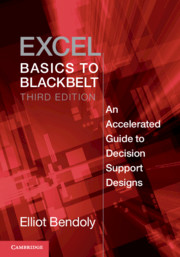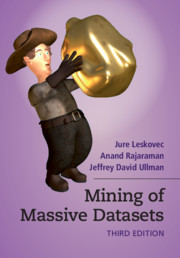Refine search
Actions for selected content:
1835 results in Knowledge Management, Databases and Data Mining
Appendix A - Workbook Shortcut (Hot Key) Reference
-
- Book:
- Excel Basics to Blackbelt
- Published online:
- 08 May 2020
- Print publication:
- 28 May 2020, pp 419-420
-
- Chapter
- Export citation
Section 3 - Prescription Development
-
- Book:
- Excel Basics to Blackbelt
- Published online:
- 08 May 2020
- Print publication:
- 28 May 2020, pp 197-304
-
- Chapter
- Export citation
Copyright page
-
- Book:
- Excel Basics to Blackbelt
- Published online:
- 08 May 2020
- Print publication:
- 28 May 2020, pp iv-iv
-
- Chapter
- Export citation
6 - The Analytics of Solution Search
- from Section 3 - Prescription Development
-
- Book:
- Excel Basics to Blackbelt
- Published online:
- 08 May 2020
- Print publication:
- 28 May 2020, pp 199-254
-
- Chapter
- Export citation

Excel Basics to Blackbelt
- An Accelerated Guide to Decision Support Designs
-
- Published online:
- 08 May 2020
- Print publication:
- 28 May 2020

Mining of Massive Datasets
-
- Published online:
- 16 April 2020
- Print publication:
- 09 January 2020
-
- Textbook
- Export citation
17 - The Statistics behind Online Controlled Experiments
- from Part V - Advanced Topics for Analyzing Experiments
-
- Book:
- Trustworthy Online Controlled Experiments
- Published online:
- 13 March 2020
- Print publication:
- 02 April 2020, pp 185-192
-
- Chapter
- Export citation
Index
-
- Book:
- Trustworthy Online Controlled Experiments
- Published online:
- 13 March 2020
- Print publication:
- 02 April 2020, pp 266-272
-
- Chapter
- Export citation
3 - Techniques
- from Part I - Conceptual Introductions
-
- Book:
- A Hands-On Introduction to Data Science
- Published online:
- 01 February 2020
- Print publication:
- 02 April 2020, pp 66-96
-
- Chapter
- Export citation
Acknowledgments
-
- Book:
- A Hands-On Introduction to Data Science
- Published online:
- 01 February 2020
- Print publication:
- 02 April 2020, pp xxii-xxiv
-
- Chapter
- Export citation
Acknowledgments
-
- Book:
- Trustworthy Online Controlled Experiments
- Published online:
- 13 March 2020
- Print publication:
- 02 April 2020, pp xvii-xviii
-
- Chapter
- Export citation
14 - Choosing a Randomization Unit
- from Part IV - Advanced Topics for Building an Experimentation Platform
-
- Book:
- Trustworthy Online Controlled Experiments
- Published online:
- 13 March 2020
- Print publication:
- 02 April 2020, pp 166-170
-
- Chapter
- Export citation
About the Author
-
- Book:
- A Hands-On Introduction to Data Science
- Published online:
- 01 February 2020
- Print publication:
- 02 April 2020, pp xx-xxi
-
- Chapter
- Export citation
10 - Unsupervised Learning
- from Part III: - Machine Learning for Data Science
-
- Book:
- A Hands-On Introduction to Data Science
- Published online:
- 01 February 2020
- Print publication:
- 02 April 2020, pp 290-318
-
- Chapter
- Export citation
References
-
- Book:
- Trustworthy Online Controlled Experiments
- Published online:
- 13 March 2020
- Print publication:
- 02 April 2020, pp 246-265
-
- Chapter
- Export citation
20 - Triggering for Improved Sensitivity
- from Part V - Advanced Topics for Analyzing Experiments
-
- Book:
- Trustworthy Online Controlled Experiments
- Published online:
- 13 March 2020
- Print publication:
- 02 April 2020, pp 209-218
-
- Chapter
- Export citation
Appendix D: Installing and Configuring Tools
-
- Book:
- A Hands-On Introduction to Data Science
- Published online:
- 01 February 2020
- Print publication:
- 02 April 2020, pp 385-389
-
- Chapter
- Export citation
11 - Hands-On with Solving Data Problems
- from Part IV - Applications, Evaluations, and Methods
-
- Book:
- A Hands-On Introduction to Data Science
- Published online:
- 01 February 2020
- Print publication:
- 02 April 2020, pp 321-353
-
- Chapter
- Export citation
5 - Python
- from Part II - Tools for Data Science
-
- Book:
- A Hands-On Introduction to Data Science
- Published online:
- 01 February 2020
- Print publication:
- 02 April 2020, pp 125-160
-
- Chapter
- Export citation
4 - UNIX
- from Part II: - Tools for Data Science
-
- Book:
- A Hands-On Introduction to Data Science
- Published online:
- 01 February 2020
- Print publication:
- 02 April 2020, pp 99-124
-
- Chapter
- Export citation
